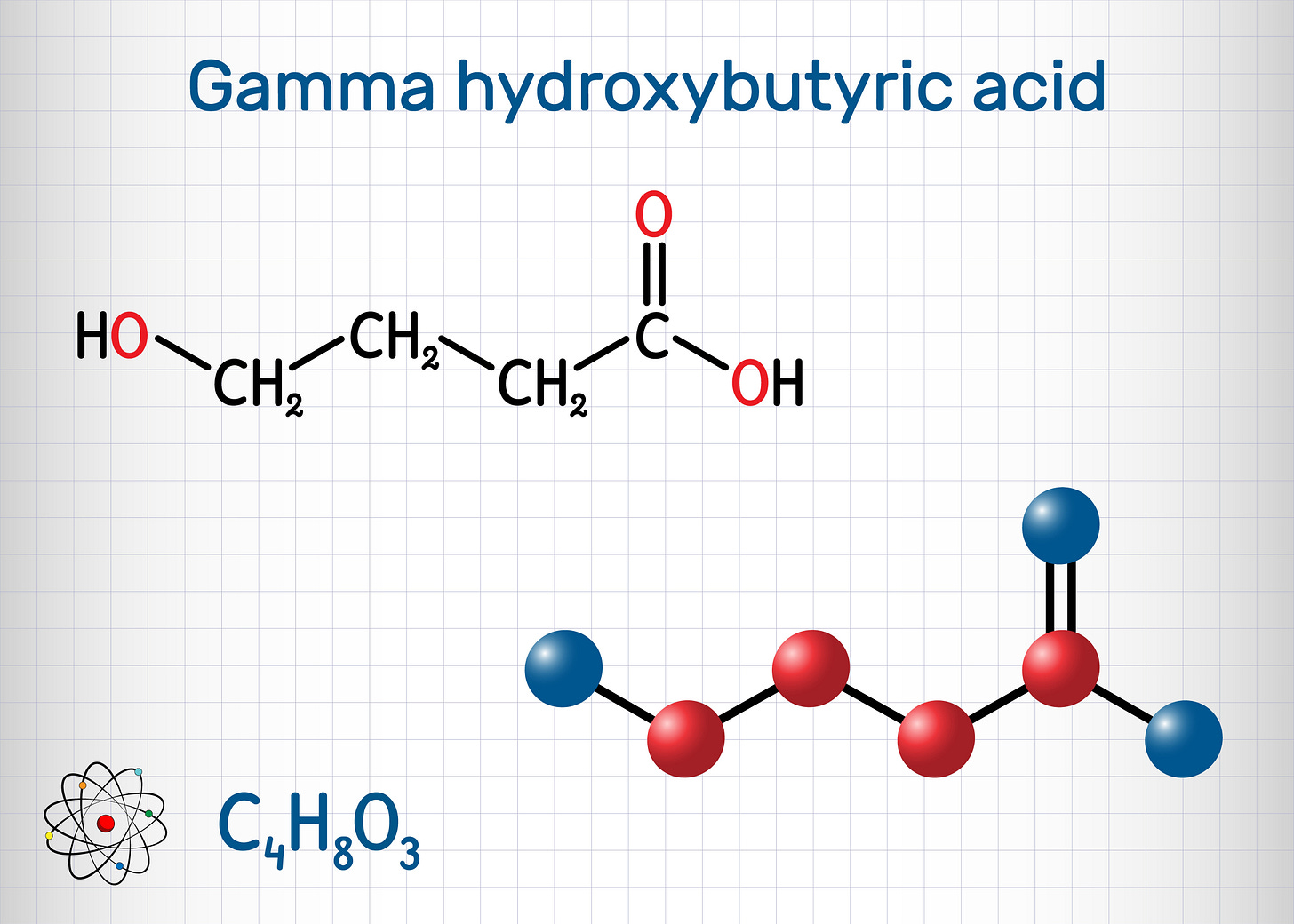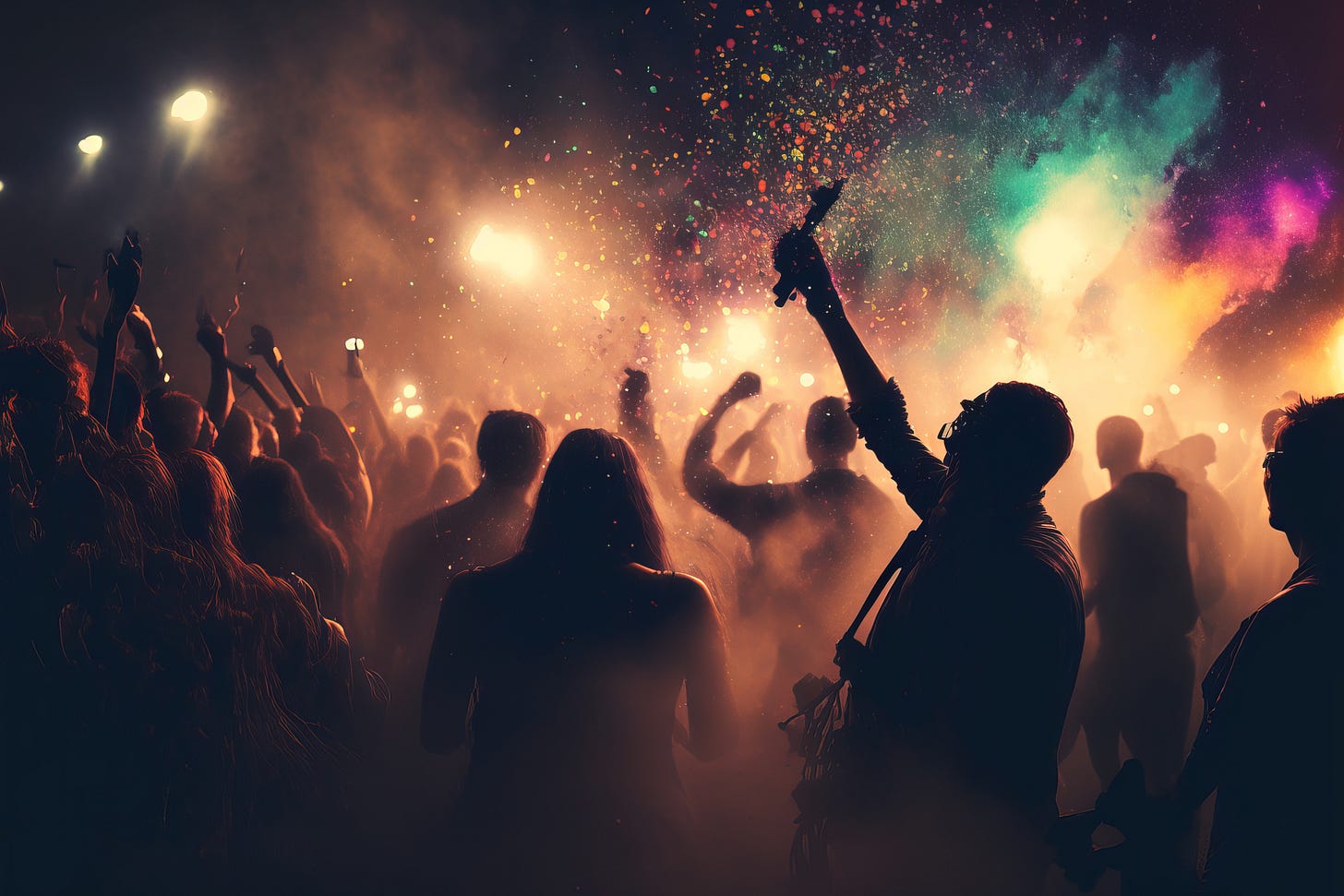GHB causing damage to young people's brains
GHB (gamma-hydroxybutyrate), also known as fantasy or liquid ecstasy, has been getting attention lately (June 2024) as it's increasingly used by young people with potential deadly consequences.
Our consciousness, most assuredly, extends beyond just our brain, encompassing our whole body and possibly beyond. Yet our optimally functioning brain provides the substrate, so to speak, the foundation upon which our consciousness can exist and rub shoulders with the infinite. Putting harmful temporary-buzz giving chemicals into a self sustaining miracle that is our brain is nuts.
Last week (May 2024) a news segment from the Australian ABC highlighted increasing use of the recreational drug known as GHB, particularly by young people. In part due to escalating cheap availability of its precursor, 1,4-BD (AKA butanediol), that gets shipped into Australia, and other countries, in 44 gallon drums for industrial use.
Because the rate of hospitalisations from GHB overdose has been concurrently increasing as reported by emergency departments, the Australian Federal Police and Australian Border Force are stepping up, as shown in the ABC segment.
I found this interesting. Since 2014 I have been fortunate to work under contract at a leading residential Alcohol and Drug recovery centre designing and delivering programs around Health and Nutrition. The people that come to the program are often asked “why are you here” and their answer always includes reference to Alcohol addiction along with use of many other drugs like Ice, Cannabis , Heroin, MDMA and others but never in 10 years - GHB.
So I looked it up. This article tells the story of what I found and it is written for several reasons. Because of my biochemistry background, it was intriguing to me that GHB is also produced naturally in the human body as a result of the neurotransmitter GABA metabolism. It is also used in Medicine at therapeutic doses. GHB is gamma-hydroxybutyrate or AKA gamma-hydroxybutyric acid or γ-hydroxybutyric acid.
But more importantly this is about raising awareness of the potential dangers to our young people. Drawing attention to the obvious acute dangers such as overdose leading to respiratory issues, addiction and even death.
We will dive deeper into the remarkable and sensitive functioning of our brain, the sheer miracle of how it self regulates and facilitates life giving functions in all organ systems via the delicate homeostatic balancing of multiple neurotransmitters and hormones.
And how substances like GHB at party drug levels, can cause serious disruption to our brains crucial functioning and potential long-term irreparable damage.
Arguably, our most valuable asset apart from life itself, is our consciousness. Our consciousness is where we live, every waking moment, every day, our whole life. It embodies everything we perceive, think about, dream and imagine, remember, and feel. See more at -
Our consciousness, most assuredly, extends beyond just our brain, encompassing our whole body and possibly beyond. Yet our optimally functioning brain provides the substrate so to speak, the foundation upon which our consciousness can exist and rub shoulders with the infinite. Putting harmful temporary-buzz giving chemicals into a self sustaining miracle that is our brain is nuts.
If you are a young person exposed or have friends potentially exposed to GHB or are a parent, teacher or health professional with some concerns, feel free to share this article while gently sharing your perspective and friendship.
The language used here is human friendly. Feel free to ask questions and leave comments.
Summary of GHB and Its Dangers
What is GHB?
GHB (gamma-hydroxybutyrate) is a chemical that can be used as a drug.
In Australia, GHB is known by several street names, some of which overlap with those used internationally, while others are more localized. Here are some common street names for GHB used in Australia -
G: A shorthand for GHB | Fantasy Often used due to its potent effects. | Grievous Bodily Harm A play on the acronym GHB | Liquid Ecstasy Highlighting its liquid form and euphoric effects | Liquid E Another variation emphasizing its liquid state | Cherry Meth Sometimes used in specific communities | Fishies Referring to small doses often sold in small plastic fish containers | Juice A casual reference to its liquid form
Why is GHB Dangerous?
Sedative Effects: GHB can make you feel very sleepy and relaxed. In high doses, it can make you pass out.
Overdose Risks: It's easy to take too much GHB because the difference between a safe dose and a dangerous one is very small. An overdose can lead to unconsciousness, trouble breathing, and even death.
Mixing with Other Substances: GHB is especially dangerous when mixed with alcohol or other drugs, increasing the risk of severe health problems.
Memory Loss: GHB can cause blackouts and memory loss, which is why it’s sometimes used in crimes like drug-facilitated sexual assault, often referred to as "date rape."
Addiction: People can become addicted to GHB. If they stop taking it suddenly, they can have serious withdrawal symptoms like anxiety, shaking, and seizures.
Industrial Use and Contaminants
GHB can be made from industrial chemicals like 1,4-butanediol (1,4-BD), which might contain harmful contaminants. These can cause additional health risks if ingested.
Key Takeaways
GHB is a very risky drug with a high potential for overdose.
It can cause memory loss, making people vulnerable to dangerous situations.
Mixing GHB with other substances can be life-threatening.
Addiction to GHB can lead to severe withdrawal symptoms.
The trio of trios - BDO, GBL and GHB explained
1,4-Butanediol (BDO or 1,4 BD) is a chemical used industrially, but it can also be converted in the body to gamma-hydroxybutyrate (GHB), a substance known for its euphoric and sedative effects.
GHB stands for gamma-hydroxybutyrate. It's used medically for certain conditions, but it's also known for its use as a recreational drug.
GBL stands for gamma-butyrolactone. It's a precursor to GHB, meaning it converts rapidly into GHB in the body.
Essentially, 1,4-butanediol and GBL both metabolize into GHB in the body, leading to their interconnected functions and effects.
1,4-Butanediol (1,4-BD) is known by several street names, particularly when used illicitly as a recreational drug. Here are some common street names for 1,4-BD in the USA:
One Four B | One Four Butane Diol | One Comma Four | 1,4-B | BDO | Butanediol | Soma | Thunder | Renaissance
These street names are used to disguise the identity of the substance in conversations and transactions.
In Australia, 1,4-Butanediol (1,4-BD) also has specific street names that are used within the community. Some of these street names may overlap with those used internationally. Common street names for 1,4-BD in Australia include:
One Four B | One Four Butane Diol | One Comma Four | 1,4-B | BDO | Thunder | Soma
Medical uses of GHB
GHB is used medically primarily to treat narcolepsy, a sleep disorder that causes excessive daytime sleepiness and sudden sleep attacks. Gamma-Hydroxybutyric acid (GHB) is marketed under the generic drug sodium oxybate called Xyrem® and is the trade name of the Food and Drug Administration (FDA)-approved prescription medication. GHB helps to reduce daytime sleepiness and cataplexy (a sudden loss of muscle tone) in people with narcolepsy. It has strict regulations due to its potential for abuse and its side effects. Xyrem is available in both the US and Australia for the treatment of narcolepsy.
Other uses of GHB
There have been claims that GHB can be used by bodybuilders to increase muscle mass because of its potential effects on growth hormone levels. GHB does increase the release of growth hormone, which can theoretically promote muscle growth. However, the scientific evidence supporting its effectiveness for muscle building is limited and not well-established. The use of GHB for this purpose is highly risky due to its side effects and potential for abuse. It is not approved for bodybuilding or performance enhancement. Using GHB for bodybuilding is not recommended due to these serious risks and the lack of substantial evidence supporting its efficacy for muscle growth. There is no substantial evidence to suggest that GHB directly increases testosterone levels.
Highly risky uses of GHB
Recent reports indicate that GHB use among young people at concerts and festivals in Australia has been on the rise. GHB is favored in these settings for its euphoric and disinhibiting effects. However, this trend raises significant health concerns due to the drug's potential for overdose and adverse interactions with other substances commonly used in such environments, like alcohol and MDMA (RACGP)
Ambulance attendances related to GHB use at festivals have highlighted the drug's dangerous side effects, including respiratory depression and loss of consciousness. GHB-related incidents are often exacerbated by its combination with other substances, leading to severe health risks and even fatalities. The National Drug and Alcohol Research Centre (NDARC) emphasised that many GHB-related deaths could be prevented with better awareness and immediate action during overdoses, such as placing individuals in the recovery position to prevent aspiration (NDARC).
Disgusting uses of GHB
Recent research indicates that GHB and its precursors, 1,4-BD and GBL, are associated with drug-facilitated sexual assault (DFSA), often referred to as "date rape" drugs.
In Australia, GHB is recognised for its sedative and amnesic effects, which can be exploited in such assaults. When ingested, GHB can cause confusion, agitation, hallucinations, blackouts, and unconsciousness, making individuals vulnerable to sexual assault (Alcohol and Drug Foundation)
A study from the Harm Reduction Journal highlights that GHB overdoses often occur in private and sexualised settings, sometimes involving multiple substances. Participants in this study reported witnessing or experiencing GHB overdoses characterized by symptoms like vomiting, sweating, convulsions, and loss of consciousness. These settings and the drug's effects contribute to its use in DFSA (BioMed Central).
Findings of GHB use highlight the need for continued public health education and harm reduction strategies to address the risks associated with GHB use in recreational settings.
GHB is also naturally produced in the human body
Note, however that these natural levels of GHB produced in the body are very low and often lower than Pharmaceutical interventions of GHB containing substances like Xyrem mentioned earlier. AND far far far lower than recreationally imbibed levels.
In the body GHB is synthesised from the neurotransmitter gamma-aminobutyric acid (GABA) and serves several functions in the central nervous system.
GHB acts as a neurotransmitter and neuromodulator in the brain. It is involved in several physiological processes, including:
Regulation of Sleep: GHB is known to promote slow-wave sleep, which is the deep, restorative stage of sleep. This is why it is used medically to treat narcolepsy, a sleep disorder.
Neuromodulation: GHB influences the release of other neurotransmitters like dopamine, which plays a critical role in mood regulation and motor control.
Metabolism: GHB also has roles in energy metabolism within the brain.
Concentration comparison of GHB - Illicit drug versus pharmaceutical versus naturally made in the body.
Naturally occurring GHB in the human brain is present at very low concentrations, typically in the nanomolar to micromolar range. This translates to levels around 10 to 50 nanograms per milliliter (ng/mL) of blood. These levels are sufficient for its physiological roles without causing adverse effects.
In contrast, the concentrations reached when GHB is taken as an illicit drug are significantly higher. Recreational and illicit use can elevate GHB concentrations in the blood to levels ranging from 100 to over 1,000 milligrams per liter (mg/L), which is several orders of magnitude higher than endogenous levels.
The difference in concentration between physiological and dangerous levels is approximately a factor of 1,000 to 10,000. Blood concentrations of GHB around 10 mg/L are considered toxic, and levels above 50 mg/L can be lethal, particularly when combined with other depressants like alcohol.
For instance, therapeutic doses of Xyrem (the medical form of GHB used to treat narcolepsy) typically result in plasma concentrations around 30 to 50 mg/L. However, doses taken recreationally or for nefarious purposes can easily exceed these therapeutic concentrations, leading to severe adverse effects such as respiratory depression, loss of consciousness, and death.
NERD ALERT
GHB is naturally regulated in the body through several biochemical mechanisms:
Synthesis and Metabolism: GHB is synthesized from GABA (gamma-aminobutyric acid) via the enzyme GABA transaminase, which converts GABA to succinic semialdehyde. Succinic semialdehyde is then reduced to GHB by the enzyme succinic semialdehyde reductase. Conversely, GHB is metabolized back into succinic semialdehyde by the enzyme GHB dehydrogenase, which is then converted into succinate and enters the Krebs cycle, a crucial metabolic pathway.
Transport and Storage: GHB levels in the brain are regulated by its uptake and release through specific transporters. It is actively transported into and out of neurons and glial cells. This regulation helps maintain appropriate concentrations of GHB in different brain regions.
Receptor Interaction: GHB exerts its effects by interacting with specific GHB receptors and GABA_B receptors in the brain. These interactions help modulate neurotransmitter release and influence various physiological processes, such as sleep and neurotransmission.
Feedback Mechanisms: The body maintains GHB levels through feedback mechanisms involving its synthesis and degradation. When GHB levels rise, the rate of its synthesis slows down, and the rate of its metabolism increases, ensuring that GHB concentrations remain within a physiological range.
These regulatory mechanisms help maintain the natural balance of GHB in the brain, allowing it to perform its normal functions without causing the adverse effects associated with higher, externally introduced doses.
Contaminants in the GHB precursor - 1,4-Butanediol (BDO)
1,4-Butanediol (1,4-BD) is used industrially and can be found in large quantities such as 44-gallon drums. It is used in the production of plastics, solvents, and other chemicals. When diverted for illicit use to be ingested as GHB, several risks arise, primarily due to potential contaminants.
Potential Contaminants in Industrial 1,4-BD:
Heavy Metals: Industrial-grade chemicals often contain traces of heavy metals like lead, mercury, and cadmium, which are toxic even in small amounts.
Organic Solvents: Residual solvents used in the production process, such as toluene or methanol, can be harmful if ingested.
By-products and Impurities: During the manufacturing process, various by-products and impurities that are not suitable for human consumption may remain in the final product.
Additives: Chemicals added to stabilize or preserve 1,4-BD in industrial applications might also pose significant health risks if ingested.
Dangers of Ingesting Contaminated 1,4-BD:
Acute Toxicity: Ingesting contaminants like heavy metals and solvents can cause immediate toxic effects, including nausea, vomiting, neurological damage, and organ failure.
Chronic Health Issues: Long-term exposure to these contaminants can lead to serious health problems, such as cancer, liver damage, and neurological disorders.
Enhanced Toxicity: Contaminants can exacerbate the toxic effects of 1,4-BD itself, increasing the risk of overdose and severe side effects like respiratory depression, loss of consciousness, and death.
Unpredictable Reactions: The presence of unknown contaminants can lead to unpredictable pharmacological reactions, making it difficult to manage and treat overdoses effectively.
Because 1,4-BD intended for industrial use is not subject to the stringent purity standards required for pharmaceutical products, ingesting it poses significant health risks.
In Conclusion
Evidence indicates that a young person’s brain isn’t fully developed till they’re somewhere between 25-30yrs and even later.
Gamma-aminobutyric acid (GABA)ergic neurotransmission, particularly in the prefrontal cortex, remains under construction during adolescence. Hence, delayed development of GABAergic neurotransmission is held responsible for neurobehavioral excitement including euphoria and risk-taking behavior, whereas dopaminergic (DA)ergic neurotransmission, particularly in the prefrontal area, is developmentally regulated by sex hormones and is implicated in drug-seeking behavior during adolescence; thus, brain development in critical areas is an ongoing process during adolescence. Indeed, adolescents are risk-taking and novelty-seeking individuals and they are more likely to weigh positive experiences more heavily and negative experiences less so than adults. This behavioural bias can lead to engagement in risky activities like reckless driving, unprotected sex, and drug abuse.In fact, most drug addictions initiate during adolescence, and early drug abuse is usually associated with an increased incidence of physical tolerance and dependence. Link
Let’s be real here. From our own human experience and as indicated above, adolescents and adults like pleasurable experiences. With age and hopefully wisdom (at least in hind-sight) adults can see the dangers in some behaviours. However young people are more vulnerable in several ways mentioned above.
Our brain is the most complex hub in the universe that takes in all information from light, sound, delicious food and exquisite textures and then communicates and facilitates our movement (walking, breathing), memory, thinking, speech and sublime natural feelings that form the basis of poetry and joy. Through the most complex feedback loops it helps maintain fully functioning organs and hormone levels. And so so much more.
People that illegally import 44 gallon drums of toxic contaminated 1,4 BD or GHB don’t give a shit about you. They just want your money.
I grew up in the 70’s and frequently saw ACDC live at lunchtime for free at Melbourne university and off course was exposed to drugs of all sorts. For what it’s worth, here are two anecdotal experiences that may add a little caution and vicarious insight into your thinking if confronted with GHB.
During that period and even today, I have had colleagues and acquaintances that died from overdose. After taking some illicit drug and looking quietly out the window as a passenger in a car during the 70’s, in my 20’s with several companions, death came visiting. The experience crept up slowly and was unusual and novel. Gradually sensations stated to get quieter and quieter within me. Almost like a peace yet intuition indicated caution as it felt like something unseen yet subtly felt had come to collect me. Ooh, I thought, I could die right here, right now. Death was close. I snapped myself out of the lull, breathed deeply a few times and catalogued the experience for serious reflection latter on. Probably through luck I didn’t die that day.
Weeks after an epiphany came calling that would change the course, or maybe reaffirm the course, my life would take. A pear. The perfect pear was made available and I ate it slowly because it was so amazingly delicious and textured with natures exquisite craftsmanship. A few days later I was thinking - how does one cope, survive, function, enjoy, move forward, thrive and work without the pleasurable experience of an external substance. The pear experience provided assistance for the epiphany that followed. The beautiful, lovely, elegant, graceful and enjoyable feeling facilitated by the pear was not in the pear - it was within me.
So from then on, in the back of my mind mostly, I moved toward knowing and understanding how one could sustainably, naturally get in touch with the source of ebullient feelings within. That thirst for a natural profound daily experience kept me going and a few years later I discovered that Knowledge of the Self is required, through a serendipitous encounter with a teacher. Enjoy reading two previous posts for more around this.
In the mean time, look after yourself (and your brain), stay conscious and choose what you imbibe, your surroundings and companions carefully.













This is such a fantastic read! Thanks ☺️
Thanks Hartmut for this brilliant and informative article. I had heard about this drug but was keen to find out more as I keep hearing about it recently. I love the wisdom you share at the end. Yes, all the beauty - and more - is within us. We just need to get still enough to discover it. Gratitude for your sharing. :)